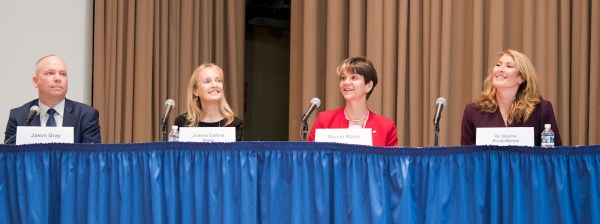Want more women in IT? Change the approach to young girls
Want more women in the federal IT workforce? Then you have to address the cultural norms and influences for young girls drawing them away from technology, a star-studded panel of federal chief information officers explained at a nonprofit luncheon Thursday.
That’s nothing new — there’s been plenty of commercialized products and movements in past years to draw girls toward technology, like a toy called Goldie Blocks intended to ignite young girls’ interest in science, technology, engineering and math (STEM) topics, and this Verizon Communications Inc. commercial that shows how cultural influences can smother that fire.
However, Thursday’s panel, featuring acting Federal CIO Lisa Schlosser, breathed fresh air into that argument, adding insight into why women should not only pursue STEM jobs but more specifically positions in federal IT.
Schlosser said driving girls’ interest toward technology starts at a young age, telling a story about the man whose role she took over last September when he stepped down as federal CIO.
“My old boss, Steven VanRoekel, has three young girls, I think under 10, and he sits down with them, and there’s a website [that teaches girls to code], and he sits down with them every day and teaches them to code,” she said, noting how changing perceptions of parents is important as well.
While many are adamant about encouraging college- and high school-aged girls to take an interest in technology, Office of Personnel Management CIO Donna Seymour said that needs to start earlier. “We’ve got to dig down a little bit and start in elementary school, maybe even kindergarten classes, where we start introducing technology earlier, and in a way, I think both boys and girls can adopt it,” Seymour said, who was encourage to practice her penmanship growing up rather than technical skills. “The boys were allowed to run around a little bit more. I think when we have an expectation, we drive people to whatever that instinct is. If we can introduce it before those norms set in, I think we would see better adoption of technology in girls as they’re coming up. We’ve go to start that pipeline a little bit sooner.”
Margie Graves, deputy CIO with the Department of Homeland Security, seconded Schlosser’s notion of “a cultural change in the parents,” pointing to the Verizon commercial, which shows how a girl is encouraged throughout her life to focus on being pretty, avoid getting her dress dirty and leave the dangerous but experimental tasks to her brother.
“The boy is encouraged to get dirty, to experiment, to build things in the garage, and the girl is told to wear her white dress and sit in the corner,” Graves said. “And those kinds of things are cultural, and we need to start to change it to a parental aspect, I would say. That’s societal.”
The panelists also pointed to showing girls of all ages the positive difference people in IT positions can make. Liz DelNegro, associate CIO of acquisition IT systems at GSA, said it’s s simple as not scaring girls away from feeling welcomed in the STEM community.
“There are some stories out there that seem to persevere,” DelNegro said, referencing a scandal that’s been coined Gamergate that caught national attention when several women in the video game community were harassed and threatened for little more than being women. She said stories like that need to be noted for being random and rare. “It’s very uncommon.”
Graves said if women want to make a difference, they should consider a future in IT. “If we tell the stories of how interesting and how impactful and how much fun this kind of work can be, and we encourage people at a very young age to study it, to get into it, to experiment with it, and then bring them along in the process and make sure we are telling them what can be done and what the impact is, because that’s really what resonates with people,” she said. “People want to make a difference.”
And that statement is especially reinforced within the federal government, where every IT job supports a greater national mission, but only 31 percent of them are held by women. “There’s nowhere else in the world that you can come in to work and one day help a veteran get a job or get a house, and then the next day have the opportunity to get a farmer a grant,” Schlosser said. “It is totally awesome to work in the government.” And even if women aren’t quite interested in spending their entire careers as federal employees, she encourages them to “come on in for a few years and be a public servant, learn and get that challenge and see that impact.”
“The opportunity and variety as well as the level of responsibility that can be afforded to you a fairly young age” is a reason why women, and really anyone, should pursue a career in federal IT, Graves said. “We’ve got some folks in our security operations center, 24 or 25 [years old], running operations that are so critical, being able to follow threats, being able to guard the networks against these kinds of intrusions. The opportunity is coming at a very young age. And I believe too that if we create the environment that allows these people to shine, I don’t see any reason why this wouldn’t be their first choice, because there is no place place on earth where you can have a greater impact.”




